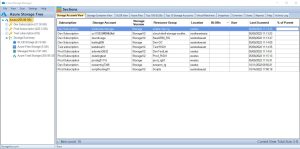Azure Blob Storage is a versatile, scalable, and cost-effective cloud storage service provided by Microsoft. It is designed to store a wide range of data types, including unstructured data such as images, videos, audio files, and documents. As businesses increasingly rely on cloud storage for critical data, ensuring the security of Azure Blob Storage becomes a top priority. This article provides a comprehensive analysis of the key factors in securing Azure Blob Storage, offering how-to guides and best practices.
Azure Blob Storage Security
Importance of Securing Azure Blob Storage
As with any cloud-based storage solution, securing Azure Blob Storage is crucial to protect sensitive data and maintain compliance with industry regulations. Implementing robust security measures helps prevent unauthorized access, data breaches, and other security threats that can have severe consequences for your organization, such as financial losses, legal penalties, and reputational damage. Moreover, a secure Azure Blob Storage environment ensures data integrity and privacy, fostering trust among customers and partners.
Best Practices for Securing Azure Blob Storage
Use of Access Keys
Access keys are one of the primary methods to authenticate and authorize access to your Azure Blob Storage account. Each storage account has two access keys, allowing you to maintain uninterrupted access while rotating keys. It is essential to secure access keys by:
- Periodically rotating them to reduce the risk of unauthorized access.
- Avoiding sharing them in plain text or source code repositories. Use Azure Key Vault or other secure storage solutions to store your access keys.
- Implementing least privilege principles and providing access keys only to users or applications that require them.
Implementing Shared Access Signatures
Shared Access Signatures (SAS) allow you to grant limited access to specific resources in your Blob Storage account without sharing your access keys. By implementing SAS, you can:
- Control the level of access by specifying permissions, such as read, write, delete, or list.
- Set an expiration time to automatically revoke access after a certain period.
- Limit access to specific IP addresses or ranges, enhancing security.
SAS tokens should be generated on-demand and not reused across multiple users or applications to minimize the risk of unauthorized access.
Utilizing Azure Active Directory (AAD)
Azure Active Directory (AAD) provides identity and access management capabilities for Azure Blob Storage. By integrating AAD, you can:
- Implement role-based access control (RBAC), which allows you to define granular permissions for users and groups based on their roles and responsibilities.
- Use Multi-Factor Authentication (MFA) to add an extra layer of security during the authentication process.
- Monitor and audit user activities in your Blob Storage account through Azure Monitor and Azure Log Analytics.
Encrypting Data at Rest
Azure Blob Storage automatically encrypts data at rest using Service-Side Encryption (SSE) with Microsoft-managed keys. For additional security, you can:
- Opt for client-side encryption, where data is encrypted before being uploaded to Azure Blob Storage. This ensures that the data is encrypted both in transit and at rest, providing an added layer of protection.
- Use Azure Key Vault to manage your encryption keys. This allows you to store and manage your keys securely, separate from your Blob Storage account. You can also control access to your keys and monitor key usage through Azure Key Vault.
Encrypting Data in Transit
Data in transit can be secured using Secure Socket Layer (SSL)/Transport Layer Security (TLS) encryption. By enforcing HTTPS-only access, you can ensure that all data transferred between your storage account and clients is encrypted and secure. To enable HTTPS-only access for your Blob Storage account, follow these steps:
- Navigate to your storage account in the Azure Portal.
- Select “Configuration” under the “Settings” section.
- Toggle the “Secure transfer required” option to “Enabled.”
Advanced Security Solutions for Azure Blob Storage
Implementing Virtual Networks and Firewalls
By integrating Azure Virtual Networks and firewalls, you can further enhance the security of your Blob Storage account. This allows you to:
- Restrict access to your Blob Storage account based on IP addresses or ranges, ensuring only authorized clients can access your data.
- Create a private network connection between your Blob Storage account and your on-premises or cloud-based resources, isolating your storage account from public internet access.
Deploying Azure Private Link
Azure Private Link enables you to access your Blob Storage account over a private connection, ensuring that your data never traverses the public internet. By deploying Azure Private Link, you can:
- Reduce your exposure to external threats, such as man-in-the-middle attacks, by keeping your data within the Azure network.
- Simplify network configuration and reduce latency by connecting directly to your Blob Storage account from your Azure Virtual Network.
- Enforce data exfiltration protection by ensuring that data only flows within your organization’s network boundaries.
Monitoring and Auditing Blob Storage
Regular monitoring and auditing of your Blob Storage account are essential for maintaining security and compliance. Azure provides several tools to help you monitor and audit your storage account, such as:
- Azure Monitor, which allows you to collect and analyze metrics and logs related to your Blob Storage account.
- Azure Log Analytics, which provides advanced querying and alerting capabilities to identify and respond to security threats.
- Azure Security Center, which offers a centralized view of your Blob Storage security posture and provides actionable recommendations to enhance security.
How-to Guides on Securing Azure Blob Storage
Below, you’ll find step-by-step guides on securing Azure Blob Storage by implementing various security features and best practices.
Implementing Role-Based Access Control (RBAC)
a. Sign in to the Azure portal (https://portal.azure.com/).
b. Navigate to your storage account and select “Access control (IAM)” from the left menu.
c. Click “+ Add” and then “Add role assignment” to open the “Add role assignment” pane.
d. Select a role from the “Role” dropdown menu. For example, choose “Storage Blob Data Contributor” to grant read, write, and delete access to Blob Storage.
e. Choose the user, group, or application to which you want to assign the role.
f. Click “Save” to apply the role assignment.
Creating Shared Access Signatures (SAS)
a. Sign in to the Azure portal (https://portal.azure.com/).
b. Navigate to your storage account and select “Shared access signature” from the left menu.
c. Configure the SAS settings, such as allowed services, resource types, permissions, and start and expiry times.
d. Click “Generate SAS and connection string” to create the SAS token.
e. Copy the generated SAS token and use it to grant access to your Blob Storage resources.
Enabling Multi-Factor Authentication (MFA)
a. Sign in to the Azure portal (https://portal.azure.com/).
b. Navigate to “Azure Active Directory” and select “Users” from the left menu.
c. Click “Multi-Factor Authentication” at the top of the page.
d. Check the box next to the user(s) for whom you want to enable MFA.
e. Click “Enable” in the toolbar, and then click “Enable multi-factor auth” in the dialog box to confirm.
Enforcing HTTPS for Secure Data Transmission
a. Sign in to the Azure portal (https://portal.azure.com/).
b. Navigate to your storage account and select “Configuration” from the left menu.
c. Under “Secure transfer required”, toggle the switch to “Enabled”.
d. Click “Save” at the top of the page to enforce HTTPS for all data transfers.
Enabling Server-Side Encryption with Storage Service Encryption (SSE)
a. Sign in to the Azure portal (https://portal.azure.com/).
b. Navigate to your storage account and select “Encryption” from the left menu.
c. Under “Blob service”, select “Microsoft-managed key” or “Customer-managed key” based on your preference.
d. Click “Save” at the top of the page to enable server-side encryption.
Configuring Soft Delete for Blob Storage
a. Sign in to the Azure portal (https://portal.azure.com/).
b. Navigate to your storage account and select “Data protection” from the left menu.
c. Under “Blob soft delete”, toggle the switch to “Enabled”.
d. Set the “Retention period (in days)” based on your data recovery needs.
e. Click “Save” at the top of the page to enable soft delete.
These guides provide a starting point for securing Azure Blob Storage. By implementing these security features and best practices, you can improve the overall security of your data stored in the cloud.
Cloud Storage Manager
Enhancing Blob Storage Insights and Cost Management
Our software, Cloud Storage Manager, provides valuable insights into Azure Blob and File Storage consumption. It generates detailed reports on storage usage and growth trends, enabling users to save money on their Azure Storage. Some of its key features include:
Comprehensive Storage Analysis
- Visualize storage consumption patterns and identify areas for optimization.
- Analyze the impact of different storage tiers and redundancy options on costs.
Usage and Growth Trend Reporting
- Receive regular reports on storage usage and growth trends.
- Use historical data to forecast future storage requirements and budgetary needs.
Cost Optimization Recommendations
- Identify opportunities for cost savings by optimizing storage configurations.
- Receive actionable recommendations for improving storage efficiency.
FAQ Section: Securing Azure Blob Storage
|
Question |
Answer |
What is Azure Blob Storage? |
Azure Blob Storage is a scalable, cost-effective cloud storage service provided by Microsoft for storing unstructured data such as images, videos, audio files, and documents. |
How can I control access to my Azure Blob Storage? |
Control access using role-based access control (RBAC), shared access signatures (SAS), and Azure Active Directory (Azure AD) integration. |
What encryption options are available for Azure Blob Storage? |
Azure Blob Storage supports encryption at rest with server-side encryption (SSE) and client-side encryption, as well as encryption in transit using HTTPS. |
How can I monitor and audit my Azure Blob Storage? |
Utilize Azure Monitor, Azure Storage Analytics, and Azure Security Center for monitoring and auditing your Blob Storage. |
What disaster recovery options does Azure Blob Storage offer? |
Azure Blob Storage provides geo-redundant storage (GRS), soft delete, and point-in-time restore (PITR) for data resilience and disaster recovery. |
How can I enforce HTTPS for secure data transmission in Azure Blob Storage? |
Enable “Secure transfer required” in your storage account’s configuration settings to enforce HTTPS for all data transfers. |
How do I enable soft delete for Blob Storage? |
In your storage account’s “Data protection” settings, toggle the switch to “Enabled” under “Blob soft delete” and set the retention period as needed. |
What are the best practices for securing Azure Blob Storage? |
Implement access control, data encryption, monitoring and auditing, disaster recovery planning, and follow security recommendations provided by Azure. |
How can Cloud Storage Manager help me save money on Azure Storage? |
Cloud Storage Manager provides storage analysis, usage and growth trend reporting, and cost optimization recommendations to identify cost-saving opportunities and improve storage efficiency. |
How do I implement role-based access control (RBAC) in Azure Blob Storage? |
Assign predefined or custom roles with specific permissions to users and groups using the “Access control (IAM)” settings in your storage account. |
How can Cloud Storage Manager help me save money on Azure Storage? |
Cloud Storage Manager provides comprehensive storage analysis, usage and growth trend reporting, and cost optimization recommendations to help users identify opportunities for cost savings and improve storage efficiency.
|
Conclusion
In conclusion, securing Azure Blob Storage involves a multi-layered approach that includes access control, data encryption, monitoring and auditing, and disaster recovery planning. Implementing best practices and leveraging tools like Cloud Storage Manager can further enhance security and cost management. As businesses continue to store critical data in the cloud, understanding and addressing these security considerations is essential for protecting valuable information and maintaining trust.


